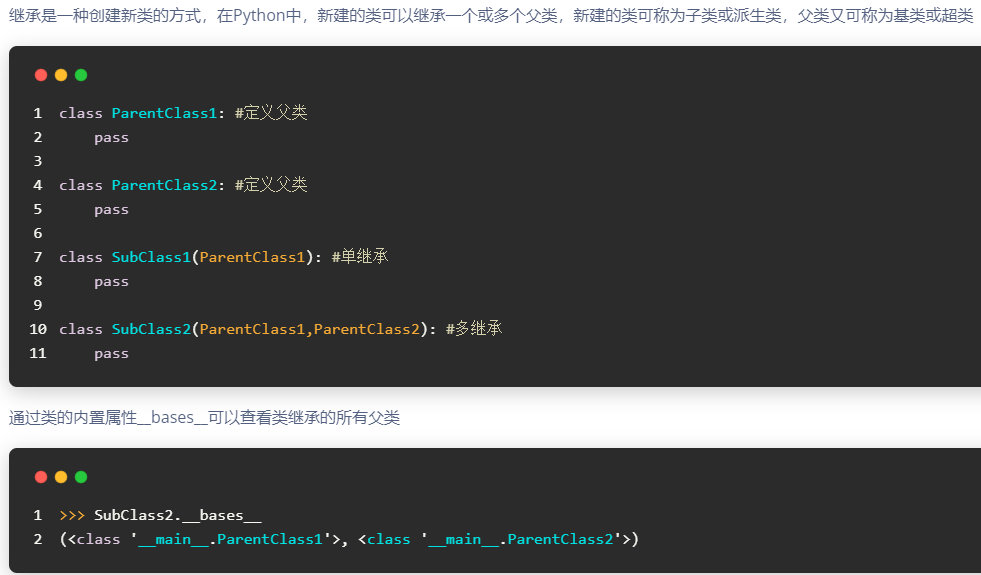面向對象的特徵之繼承
今日內容概要
- 面向對象的三大特徵
- 繼承的屬性查找順序
- super()和mro()列表
- 多態與多態性(了解)

內容詳細
封裝
# 將功能封裝成函數
# 在類中 我們正常定義的方法 就是封裝

繼承(概念)
1.什麼是繼承
'''
繼承就是新建類的一種方式 新建的類我們稱之為 子類 或者 派生類
被繼承的類稱之為 父類 或者 基類
子類可以使用父類中的屬性或方法
'''
2.為什麼要用繼承
'''
類解決了對象與對象之間的程式碼冗餘問題
繼承解決的是類與類之間的程式碼冗餘問題
'''
3.如何使用繼承
# 新式類
繼承了object類的子子孫孫類
# 經典類
沒有繼承object類的子子孫孫類
'''
新式類和經典類只在python2中區分
python3隻有新式類
'''

繼承實例
# 以學生選課系統為例
# 定義父類
class People:
school = 'SH'
def __init__(self, name, age, gender):
self.name = name
self.age = age
self.gender = gender
# 定義學生類(子類)
class Student(People): # 繼承父類People
def __init__(self, name, age, gender, course=None):
if course is None:
course = []
People.__init__(self, name, age, gender)
self.courses = course
def choose_course(self, course):
self.courses.append(course)
print('%s 選課成功 %s' % (self.name, self.courses))
stu = Student('ly', 19, 'male')
print(stu.name) # ly
# 定義老師類(子類)
class Teacher(People): # 繼承父類People
def __init__(self, name, age, gender, level):
self.level = level
People.__init__(self, name, age, gender)
def score(self, stu_obj, score):
stu_obj.score = score # 給學生打分
print('%s給%s打了%s分' % (self.name, stu_obj.name, score))
tea = Teacher('ly', 19, 'male', 10)
print(tea.name) # ly
print(tea.level) # 10

單繼承下的屬性查找
class Foo:
def f1(self):
print('Foo.f1')
def f2(self):
print('Foo.f2') # 1
self.f1() # self = obj = Bar 所以要找 Bar中的 f1
class Bar(Foo):
def f1(self):
print('Bar.f1') # 2
obj = Bar() # {}
print(Bar.mro()) # [<class '__main__.Bar'>, <class '__main__.Foo'>, <class 'object'>] 查找空間順序
obj.f2()
'''
列印結果:
Foo.f2
Bar.f1
'''
# 練習
class Foo:
def __f1(self): # _Foo__f1()
print('Foo.f1')
def f2(self):
print('Foo.f2') # 1
self.__f1() # _Foo__f1() 此處的__f1是屬於Foo類空間產生的f2對象空間中 所以結果是 Foo.f1
class Bar(Foo):
def __f1(self): # # _Bar__f1()
print('Bar.f1')
obj = Bar() # {}
print(Bar.mro()) # [<class '__main__.Bar'>, <class '__main__.Foo'>, <class 'object'>] 查找空間順序
obj.f2()
'''
列印結果:
Foo.f2
Foo.f1
'''

多繼承下的屬性查找
# 新式類:按照廣度優先查詢(經典類:按照深度優先查詢)
class A(object):
def test(self):
print('from A')
class B(A):
def test(self):
print('from B')
pass
class C(A):
def test(self):
print('from C')
pass
class D(B):
# def test(self):
# print('from D')
pass
class E(C):
# def test(self):
# print('from E')
pass
class F(D, E):
# def test(self):
# print('from F')
pass
f1 = F()
f1.test()
print(F.mro()) # 查找順序按照 [<class '__main__.F'>, <class '__main__.D'>, <class '__main__.B'>, <class '__main__.E'>, <class '__main__.C'>, <class '__main__.A'>, <class 'object'>] 找不到就下一個類 不能返回查找
'''
列印結果:
from B
'''

super()和mro列表
# 父類
class People():
school = 'SH'
def __init__(self, name, age, gender):
self.name = name
self.age = age
self.gender = gender
# 學生類(子類)
class Student(People):
def __init__(self, name, age, gender, course=None):
if course is None:
course = []
# People.__init__(self, name, age, gender) # 指名道姓的調用父類的方法
# super(Student, self) 返回了一個特殊的對象
# 它的使用遵從mro列表
# super(Student, self).__init__(name, age, gender) # python2的寫法
super().__init__(name, age, gender) # python3 的寫法
self.courses = course
def choose_course(self, course):
self.courses.append(course)
print('%s 選課成功 %s' % (self.name, self.courses))
stu = Student('ly', 19, 'male')
print(stu.name) # ly
# 老師類(子類)
class Teacher(People):
def __init__(self, name, age, gender, level):
self.level = level
People.__init__(self, name, age, gender)
def score(self, stu_obj, score):
stu_obj.score = score # 給學生打分
print('%s給%s打了%s分' % (self.name, stu_obj.name, score))
tea = Teacher('ly', 19, 'male', 10)
print(tea.name) # ly
print(tea.level) # 10
# 例題1
class A:
def test(self):
print('from A.test')
super().test()
class B:
def test(self):
print('from B')
class C(A, B):
pass
c = C()
c.test()
print(C.__mro__) # 查找順序 按照mro列表 由C3線性演算法產生 (<class '__main__.C'>, <class '__main__.A'>, <class '__main__.B'>, <class 'object'>)
'''
列印結果:
from A.test
from B
'''
# 例題2
class B:
def test(self):
print('B---->test')
def aaa(self):
print('B---->aaa')
class A:
def test(self):
print('A---->test')
super().aaa()
class C(A, B):
def aaa(self):
print('C----->aaa')
c = A()
c.test() # 列印結果: A---->test + 報錯
print(A.mro()) # 查找順序 [<class '__main__.A'>, <class 'object'>] A類找不到就直接報錯

多態和多態性(了解)
1.什麼是多態
水:
液態水 固態水 氣態水
動物:
人 豬 狗 貓...
# 抽象類 定義
抽象類只能被繼承 不能被實例化
# 固定語法
import abc
class Animal(metaclass=abc.ABCMeta):
@abc.abstractmethod # 該方法已經是抽象方法了
def speak(self): pass
@abc.abstractmethod # 子類函數必須含有 login 方法 沒有就會直接報錯
def login(self): pass
class People(Animal):
def speak(self):
print('嗷嗷嗷')
def login(self): # 子類函數必須含有 login 方法 沒有就會直接報錯
pass
'''
如果定義抽象類了 那麼子類當中必須由抽象類的方法名
即使子類函數體程式碼為pass也可
否則將直接報錯 而不會再到抽象類(父類)查找
eg:
class People(Animal):
def jiao(self):
print('嗷嗷嗷')
obj = People()
obj.speak()
列印結果:
直接報錯
'''
class Pig(Animal):
def speak(self):
print('哼哼哼')
class Dog(Animal):
def speak(self):
print('汪汪汪')
obj = People()
obj.speak()
'''
列印結果:
嗷嗷嗷
'''
# 在python3中 抽象類寫法墨守成規為以下
# 省去了abc模組固定語法
class People():
def speak(self):
print('嗷嗷嗷')
class Pig():
def speak(self):
print('哼哼哼')
class Dog():
def speak(self):
print('汪汪汪')
class Txt():
def speak(self):
print('Txt')
obj = People()
obj1 = Pig()
obj2 = Dog()
obj3 = Txt()
# 多態帶來的特性:在不用考慮對象數據類型的情況下,直接調用對應的函數 封裝成函數調用
def animal(animal):
return animal.speak()
animal(obj)
animal(obj1)
animal(obj2)
animal(obj3)
# len 就是多態一種場景
len('abc')
len([1, 2, 3])
len({'username': 'ly'})
def len(item):
return item.__len__()
print(len('abc'))
# 父類限制子類的行為(抽象類) 還可以用異常捕獲主動報錯
class Animal():
def speak(self):
raise Exception("必須實現speak方法") # 主動報錯出去
class People(Animal):
pass
class Pig():
def speak(self):
print('哼哼哼')
class Dog():
def speak(self):
print('汪汪汪')
obj = People()
obj.speak()
# 一切皆文件 只要類中含有read,write方法 就看做文件類
class Txt:
def read(self):
pass
def write(self):
pass
class Process():
def read(self):
pass
def write(self):
pass











